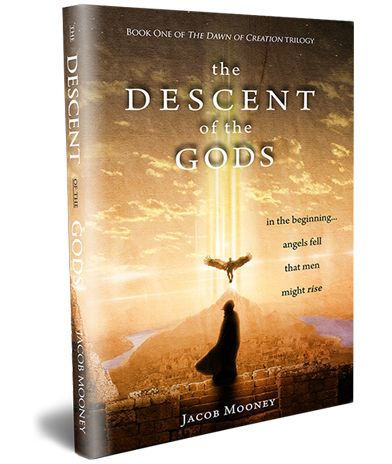Dr. Peter Gentry, professor of the Old Testament at Southern Baptist Theological Seminary, offers a scholarly and nuanced view of Genesis 6:1-4, which speaks of the “sons of God” who married the “daughters of men,” leading to the creation of the Nephilim.
Dr. Gentry examines the various interpretations of this text and explains why he believes the best interpretation is that the “sons of God” were actually angelic beings, rather than the descendants of Seth or heroic figures from myth.
Let’s explore Dr. Gentry’s perspectives further…
Who were the Sons of God?
The Old Testament
Dr. Gentry shares that the phrase “sons of God” appears only four or five times in the Hebrew Bible.
The first occurrence is in Genesis 6:1-4, but the other three references are in the introduction to the book of Job and in Daniel.
In Job, God is depicted as gathering his heavenly court, including angels referred to as the “sons of God.” In Daniel, a person in the furnace is described as looking like a “son of God,” meaning a divine or angelic being.
There are only five occurrences in the entire Bible where we have the exact expression, son of God or sons of God and it always refers to angelic beings…
Dr. Peter Gentry
Gentry notes that the phrase “sons of God” always refers to angelic beings, and that it is distinct from other places in the Bible where humans are described as having a father-son relationship with God.
While Adam and God, and David and God, are said to have a father-son relationship, they are never referred to as “sons of God.”
There is no other story in the Old Testament that it could be referring to… Peter is very clearly alluding to Genesis 6. Jude is doing the same thing…
Dr. Peter Gentry
The New Testament Witness

Dr. Gentry discusses the New Testament passages of 2 Peter chapter 2 and the book of Jude, which both reference difficult times for Christians and the presence of false teachers who deny the gospel. Peter appeals to the Old Testament and cites the examples of Genesis 6 and Noah, and Lot being rescued from Sodom and Gomorrah as evidence that God will deliver his faithful people.
Some argue that Peter may be referring to the fall of Satan, but Gentry explains that there is no such story in the Old Testament.
Jude also references the Old Testament and the examples of angels who abandoned their proper dwelling place and the cities of Sodom and Gomorrah. Gentry notes that the connection between these stories is the presence of abnormal sexuality.
Some may argue that Jesus’ statement in the gospels about angels not marrying contradicts the notion of angels having physical relations with human women, but Gentry explains that Jesus is referring to the angels in heaven, while Jude is referring to angels who abandoned their proper dwelling place. Therefore, there is no confusion or contradiction between the two passages.
Therefore, according to Dr. Gentry, it seems clear that the “sons of God” in Genesis 6:1-4 are not human.
Who were the Nephilim?
Dr. Gentry acknowledges that many believe (like detailed in the Book of Enoch) that the union of the “sons of God” and the “daughters of men” led to the creation of the Nephilim.
Dr. Gentry suggests that the text also allows for the existence of the Nephilim to be unrelated to the sin of the angels, and that they were ‘on the earth’ both before and after the angelic incursion.
The Nephilim were on the earth in those days, and also afterward, when the sons of God came in to the daughters of man and they bore children to them. These were the mighty men who were of old, the men of renown.
Genesis 6:4
Dr. Peter Gentry believes that the second interpretation is correct, for two main reasons.
- First, upon examination of every occurrence of the phrase “and also afterward” in the Hebrew Bible, he believes that the second interpretation best suits its usage.
- Second, the sentence “they were the heroes who were from the ancient past, the men of renown” does not begin with “and,” indicating that it is a footnote rather than a new section. Moses, the author of Genesis, is simply demythologizing the Nephilim, making it clear that they were not a part of the story involving the cohabitation of angels and humans.
What Moses is doing is he’s demythologizing the nephilim…
Dr. Peter Gentry
While the text doesn’t tell us who the Nephilim were, Dr. Gentry believes that the first readers of this text knew who they were and didn’t need an explanation.
What did the 2nd Temple writers get wrong?
Dr Peter Gentry believes that the interpretation of the term “nephilim” has been misunderstood throughout history.
In the third century BC and the second-century BC they came to an incorrect interpretation they thought that the nephilim were giants who were produced by angels cohabiting with humans…”
Dr. Peter Gentry
Dr Gentry explains that the interpretation which associates the nephilim with giants resulting from angelic unions was expanded on in the book of Enoch, a third and second-century BC work. He notes that this interpretation blames the world’s chaos, death, and evil on angelic sin instead of human sin, contrary to the Bible’s teachings.
According to Dr Gentry, the Bible attributes the blame for the world’s troubles to human rebellion and disobedience towards God’s covenant, not the angelic incursion of Genesis 6, in stark contrast to The Book of Enoch’s narrative.
More reading
For a discussion on the topic between Dr. Gentry and Dr. Michael Heiser, please see Addendum to Peter Gentry on the Nephilim.
About Dr. Gentry
Dr. Peter Gentry is a Visiting Professor of Old Testament and Senior Research Fellow of the Text & Canon Institute at Phoenix Seminary. He has previously taught at The Southern Baptist Theological Seminary and Toronto Baptist Seminary for a total of 37 years. Dr. Gentry has authored many books and articles and is currently writing a commentary on Isaiah. He is passionate about teaching courses in biblical languages, exegesis, and biblical theology.







